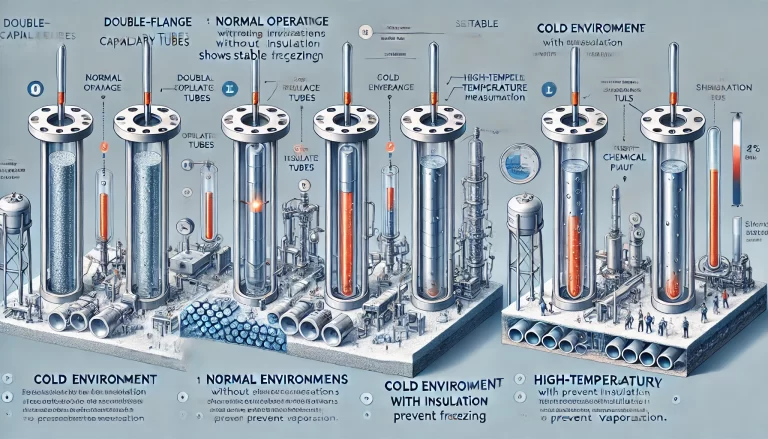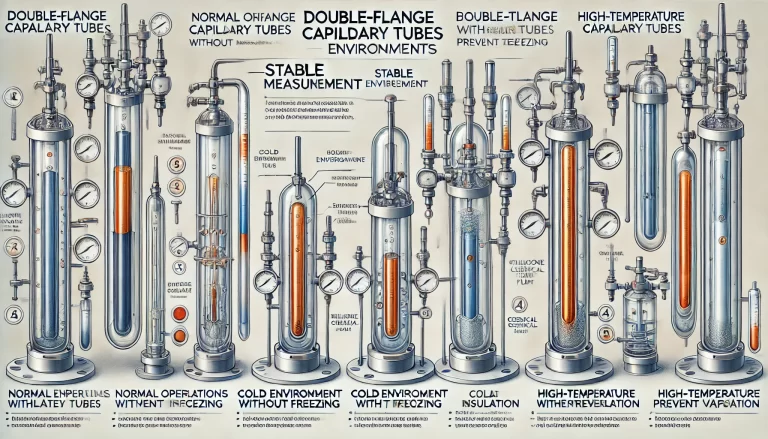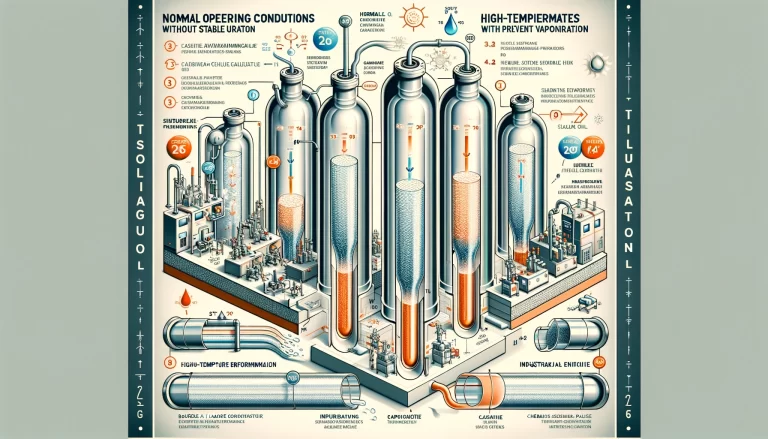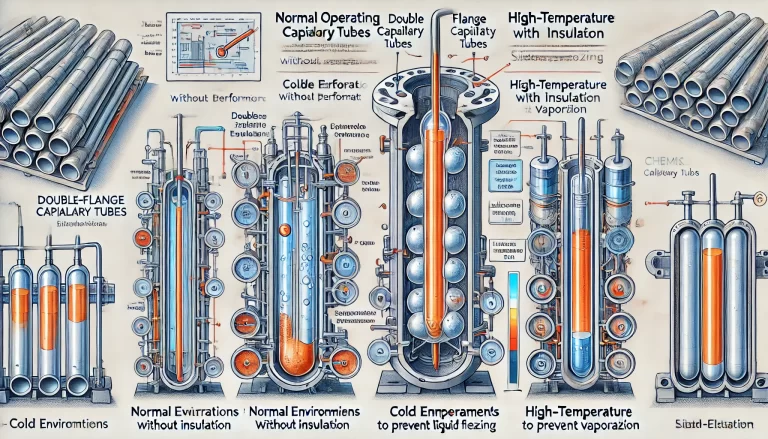1. The Necessity of Insulating Double-Flange Capillary Tubes
Whether double-flange capillary tubes require insulation depends on the specific application environment and conditions. Below are the key scenarios:
1.1 Generally, Insulation is Not Required
Under normal operating conditions, the filling liquid inside double-flange capillary tubes (e.g., silicone oil) is designed to adapt to environmental temperature changes without requiring additional insulation. These liquids typically have good thermal stability, ensuring reliable performance in moderate conditions.
1.2 Insulation is Required in Cold or Harsh Environments
In extremely cold regions or environments where temperatures drop below the freezing point of the filling liquid, the liquid may become viscous or even solidify. This can severely affect measurement accuracy and instrument performance.
- Example: In northern regions during winter, capillary tubes exposed to sub-zero temperatures without insulation might lead to frozen filling liquids, causing inaccurate pressure readings or sensor failure.
1.3 Insulation for Specific Conditions
When capillary tubes are installed outdoors, near heat or cooling sources, or in extreme temperature environments, insulation becomes essential to prevent temperature fluctuations from affecting measurement accuracy.
- Example: In industrial chemical plants where equipment operates near high-temperature reactors or cryogenic storage units, localized temperature extremes can significantly impact the performance of capillary tubes.
1.4 Avoid Overheating During Insulation
While insulation helps stabilize temperature, excessive heating can lead to the vaporization of the filling liquid, which might damage the sensor. Careful control of insulation and auxiliary heating systems is crucial.
- Example: Overheated silicone oil inside capillary tubes might vaporize, creating air pockets and disrupting pressure signal transmission.
Summary: Whether insulation is needed depends on ambient temperature, filling liquid properties, and installation location. In normal environments, insulation is typically unnecessary. However, for low-temperature, high-temperature, or rapidly fluctuating environments, appropriate insulation is highly recommended.

2. Performance Changes of Double-Flange Capillary Tubes at Different Temperatures
Temperature changes significantly influence the performance of double-flange capillary tubes. Below are the primary areas of impact:
2.1 Changes in Filling Liquid Density
The density of the filling liquid (e.g., silicone oil) varies with temperature changes:
- At higher temperatures: The filling liquid expands, reducing its density.
- At lower temperatures: The liquid contracts, increasing its density.
These density changes affect the static pressure inside the capillary tube, potentially causing measurement deviations.
- Example: In winter, the temperature difference between daytime and nighttime can cause noticeable density changes, leading to pressure measurement errors.
2.2 Zero Point Drift
Temperature-induced density changes can result in zero point drift. Even if the two capillaries are of equal length, temperature variations cannot perfectly offset the static pressure difference caused by density changes.
- Example: For a DN80 double-flange differential pressure transmitter, when ambient temperature rises from 25°C to 45°C, zero point drift of approximately 280 Pa can occur.
2.3 Measurement Errors
Temperature variations not only affect liquid density but can also cause uneven pressure transmission along the capillary tube. This phenomenon is especially evident in extreme high or low temperatures.
- Example: In high-temperature environments, silicone oil near the container might expand more rapidly than silicone oil further along the capillary tube, causing unbalanced pressure transmission and inaccurate level measurements.
2.4 Response Speed
Capillary tubes with smaller inner diameters offer higher resistance to pressure transmission, slowing down response times. Similarly, longer capillary tubes have longer transmission paths, increasing response delays.
- Example: In high-temperature environments, rapid expansion of the filling liquid may further reduce response speeds, impacting real-time monitoring.
Summary: Temperature variations affect the density of the filling liquid, zero point stability, measurement accuracy, and response speed. These effects are more pronounced in extreme environments.

3. Compensation Solutions for Temperature Variations
To minimize the impact of temperature changes on measurement accuracy, the following compensation strategies can be adopted:
3.1 Unequal Length Capillary Compensation
By precisely calculating the thermal expansion differences between capillaries of unequal lengths, it is possible to partially offset temperature-induced errors.
- Implementation Example: In a system with extreme temperature variation, adjusting the length of the capillary tubes can balance the temperature expansion differentials, thereby reducing error margins.
3.2 Optimal Filling Liquid Selection
Choosing a filling liquid with a low thermal expansion coefficient can help minimize temperature-induced density changes.
- Recommended Liquids: Silicone oils with high thermal stability are generally preferred for environments with wide temperature ranges.
3.3 Environmental Control
In critical installations, additional environmental controls (e.g., temperature-controlled enclosures) may be used to reduce the impact of external temperature variations.
3.4 Regular Calibration and Maintenance
Periodic calibration and maintenance of capillary tube systems are essential to detect and address temperature-induced deviations before they affect operations.

4. Case Study Example
Scenario: A differential pressure transmitter installed in a chemical processing plant experienced inconsistent readings due to seasonal temperature fluctuations.
- Problem Identified: Temperature changes caused density variations in the filling liquid, leading to zero-point drift and measurement errors.
- Solution Implemented: The plant installed insulated capillary tubes with precise length adjustments and switched to a high-stability silicone oil.
- Outcome: Measurement stability improved significantly, and error margins decreased by 30%.

5. Conclusion
The necessity of insulating double-flange capillary tubes depends heavily on environmental conditions, filling liquid properties, and specific operational requirements. Key takeaways include:
- Insulation is unnecessary under moderate conditions but essential in extreme temperature environments.
- Temperature changes primarily affect filling liquid density, zero point stability, measurement accuracy, and response speed.
- Compensation strategies, such as unequal length capillary designs, optimal filling liquid selection, and regular calibration, are crucial for maintaining measurement precision.
By implementing appropriate insulation and compensation measures, industries can ensure accurate, reliable, and long-lasting performance of double-flange capillary systems.
